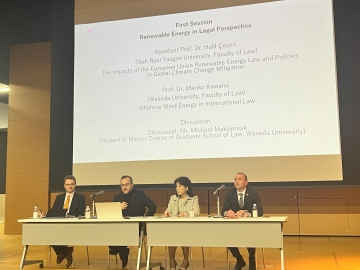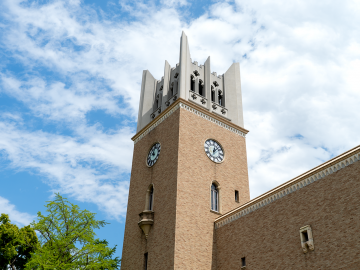Topics in Japanese Law (Important Cases)
The case in which a part of Article 733(1) of the Civil Code, stipulating a prohibition period for remarriage specific to women, was ruled as unconstitutional.
Final ruling on December 16, 2015
Supreme Court Civil Casebook (Minshu), Vol. 69, No. 8, p. 2427
Associate Professor Takashi KANAZAWA
Faculty of Law, Waseda University
Article completed: February 28, 2017
On December 16, 2015, the Supreme Court judged the constitutionality of two provisions of the Civil Code. One judgment, which will be addressed here, was that Article 733(1) of the Civil Code violates the Constitution; the other judgment was that Article 750 of the Civil Code, which stipulates that spouses must make their surnames the same upon marriage, does not violate the Constitution.※
Article 733(1) of the Civil Code stipulated a six-month prohibition period for remarriage for women only. Men may remarry immediately after divorce, whilst women must wait half a year. In the case in question, the plaintiff claimed damages from the state (the defendant), stating that they had suffered emotional distress caused by their delayed remarriage due to this provision. The specific issues were: (1) whether or not this provision violates Articles 14(1) and 24(2) of the Constitution, both of which stipulate gender equality; (2) whether or not legislative inaction, i.e., not abolishing such unconstitutional provisions, is unlawful. The plaintiff lost at lower courts and subsequently.
The Supreme Court had, in fact, been asked to judge the constitutionality of Article 733(1) of the Civil Code once before, in 1995. Then, the focus was narrowed to only issue (2) above, carefully avoiding judgment of (1). The act of Diet members not abolishing existing legislation is unlawful only in extremely exceptional cases—when it is clear at first glance that the legislation violates was deemed to not apply in the least to the provision in question.
Since then, there have been strong doubts in constitutional law theorists about the constitutionality of Article 733(1) of the Civil Code. We may therefore see the ruling this time as a response from the Supreme Court to a question that has been pending for 20 years.
The majority opinion held that the prohibition period for remarriage beyond 100 days had no rational basis and worked against the interests of women, thus, violating Articles 14(1) and 24(2) of the Constitution. The reason is as follows. The prohibition period for remarriage was created to avoid uncertainty regarding the paternity of a newborn child. Article 772(2) of the Civil Code presumes a child born 200 days after the formation of marriage or within 300 days of the dissolution or rescission of marriage to be a child within that marriage. For the resulting overlap period of 100 days, it is not certain whether the child is of the former or latter marriage. Therefore, surely, the prohibition period for remarriage suffices if set at most 100 days. Recent years have also seen movements to abolish the prohibition period for remarriage in various overseas states, such as France and Germany. Six months, therefore, is an excessive and unreasonable restriction. Meanwhile, even whilst using quite different standards from the 1995 ruling, it was concluded that illegality could not be asserted in issue (2).
Further, two Supreme Court judges decided in a minority opinion that the prohibition period for remarriage, even at 100 days, was unreasonable. Following the advance of DNA testing technology, it is now easy to ascertain the paternity of a child. Nonetheless, to uniformly impose the burden of a remarriage prohibition only upon women is unfair. Moreover, one of these judges opposed the majority opinion, expressing that the appeal for damages could also be approved.
Based on the fact that the majority opinion did not approve the appeal for damages, formally the plaintiff (i.e., the appealing party) lost the case. Yet, in substantial terms, we may view the case as having been successful, seeing as the Supreme Court declared the six-month prohibition period for remarriage to be unconstitutional. After the ruling, the National Diet quickly revised the Civil Code and shortened the women’s prohibition period for remarriage to 100 days.
This ruling is the 10th judgment of unconstitutionality since the Japanese Constitution took effect in 1947. In other words, over the last seven decades, the Supreme Court has judged legislation established by the National Diet to violate the Constitution in only 10 instances. Compared with the United States, where judicial courts use a similar system to that of Japan which includes rulings on the constitutionality of legislation insofar as necessary for case resolution, this small number is extraordinary. Of course it is meaningless to make simple “quantitative” comparisons, since the United States and Japan have differing systems of governance as a whole. Yet such a small “quantitative” number makes “qualitative” assessment itself difficult.
Based on the limited number of unconstitutional rulings, the Supreme Court of Japan has a strongly passive character overall. Nonetheless, a separate trend may be seen if we focus on recent years. Of the 10 rulings of unconstitutionality, five—i.e., half—occurred from 2002 onwards. It may thus be feasible to see a relatively active posture towards rulings of unconstitutionality in the past decade or so. I myself interpret the Supreme Court to currently be in a period of gradual transition.
After 20 years since it first encounter with Article 733(1), the Supreme Court finally came to judge Article 733(1) of the Civil Code as unconstitutional. In 2015, the Supreme Court had its first encounter with Article 750 of the Civil Code—ruling it to be constitutional. However, we may question whether this provision will ever be judged as unconstitutional. If so, when? The seriousness of judicial practice by the Supreme Court is now being tested .
※Please see separate articles for details of this latter judgment.







